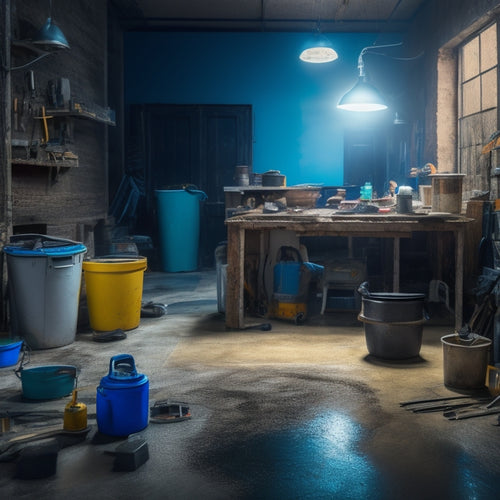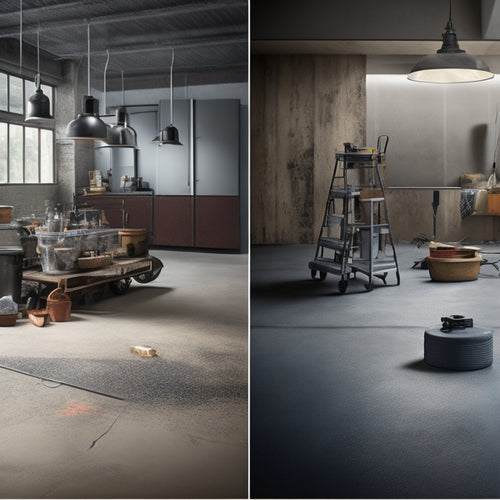
Essential Tools for DIY Concrete Grinding Projects
Share
When tackling a DIY concrete grinding project, you'll need a variety of specialized tools to achieve professional-looking results. First, choose a high-quality grinder that suits your project's specific needs, considering factors like size, power, and surface preparation level. Diamond grinding wheels are also essential, with options ranging from metal-bonded for heavy removal to resin-bonded for polishing. Additionally, consider scarifier options, hand-held edger tools, and dust management systems to guarantee a smooth and safe process. From there, you can explore other critical tools and techniques to guarantee your project's success - and we'll cover those in more detail next.
Key Takeaways
• Choose the right grinder type (angle, walk-behind, or handheld) based on the size and type of area to be ground.
• Select diamond grinding wheels with appropriate grit size, bond hardness, and material for the specific concrete surface preparation task.
• Utilize scarifying tools with depth control features to achieve precise cutting depth adjustments and prevent damage to the underlying surface.
• Ensure proper dust management with concrete dust collectors or central vacuum systems to prevent respiratory issues and visibility problems.
• Wear essential safety gear, including protective clothing, eye protection, and dust masks or respirators, to prevent injuries and health risks.
Choosing the Right Grinder
When selecting a grinder for your DIY concrete grinding project, evaluate the size and type of area you need to grind, as well as the level of surface preparation required, to guarantee you choose the right tool for the job.
There are various grinder types to choose from, including angle grinders, walk-behind grinders, and handheld grinders. Each type is suited for specific tasks and surface areas. For instance, angle grinders are ideal for small to medium-sized areas, while walk-behind grinders are better suited for larger areas.
You'll also need to evaluate power options. Do you prefer electric, battery-powered, or gas-powered grinders? Electric grinders are suitable for small to medium-sized projects, while gas-powered grinders provide more power and are ideal for larger projects. Battery-powered grinders offer portability and convenience.
Additionally, think about the level of surface preparation required. Will you need to remove old coatings, smooth out rough surfaces, or achieve a high-gloss finish? By evaluating these factors, you'll be able to select the right grinder for your DIY concrete grinding project, ensuring you achieve professional-looking results.
Diamond Grinding Wheels
When selecting a diamond grinding wheel, you'll need to take into account the type of concrete you're working with, the level of grinding required, and the desired finish.
You'll want to choose a wheel that's specifically designed for your project's unique demands.
Wheel Selection Guide
You'll need to choose the right diamond grinding wheel for your concrete grinding project, as the wheel's characteristics greatly impact the grinding process and its results.
The first consideration is the wheel material. Diamond grinding wheels come in two main types: metal-bonded and resin-bonded. Metal-bonded wheels are more aggressive and suitable for heavy removal of concrete, while resin-bonded wheels are better for finer grinding and polishing.
Next, you'll need to select the appropriate grit size. Grit sizes range from coarse (16-30) to fine (80-120) and are used for specific grinding tasks. Coarser grits are used for removing old coatings or rough concrete, while finer grits are used for smoothing and polishing. A general rule of thumb is to start with a coarse grit and progress to finer grits for a higher-gloss finish.
Additionally, consider the wheel's bond hardness, which affects its ability to grind efficiently. Softer bonds are better for harder concrete, while harder bonds are better for softer concrete.
Grinding Performance Tips
Selecting the right diamond grinding wheel is just the first step; to achieve peak grinding performance, it's vital to operate the wheel correctly, maintaining a consistent angle and adequate water flow to prevent overheating and extend its lifespan.
When you're grinding, keep the wheel moving in a consistent pattern, applying moderate to heavy pressure, depending on the surface preparation goal. Avoid applying too much pressure, which can lead to uneven grinding and wheel damage.
Mastering different grinding techniques is fundamental for achieving ideal results. For instance, using a slow, sweeping motion can help remove old coatings or adhesive residue, while a faster, more aggressive approach is better suited for heavy concrete removal.
It's also important to adjust your technique based on the specific surface you're working with. By doing so, you'll be able to achieve a smoother, more even finish, and guarantee a strong bond between the concrete and any subsequent coatings or overlays.
Concrete Scarifier Options
When selecting a concrete scarifier, you'll need to contemplate the type of scarifier that best suits your project's requirements.
You'll also want to think about the depth control options you need, as this will impact the effectiveness of the scarifier.
Additionally, you should factor in the maintenance requirements of the scarifier, as this will affect its overall performance and longevity.
Scarifier Types Available
By exploring the various concrete scarifier options, you can choose the right tool for your specific project needs. Scarifiers are versatile tools that can be used for various applications, including removing old coatings, cleaning surfaces, and preparing concrete for further treatment. When selecting a scarifier, take into account the type of project you're working on and the surface you're working with.
There are several types of scarifiers available, each designed for specific scarifier applications. For example, planetary scarifiers are ideal for large, open areas, while walk-behind scarifiers are better suited for smaller, more confined spaces. You'll also want to take into account the drum size and rotation speed, as these factors will impact the scarifier's performance and efficiency.
Proper scarifier maintenance is also vital to guarantee peak performance and extend the tool's lifespan. Regularly inspect and replace worn or damaged parts, and keep the scarifier clean and well-lubricated.
Depth Control Options
You can achieve precise control over the scarifying process with depth control options, which enable you to adjust the scarifier's cutting depth to suit specific project requirements. This feature is essential in ensuring that you remove the desired amount of concrete, without damaging the underlying surface.
To make effective depth adjustments, you'll need to employ reliable depth measurement techniques. Here are three methods to take into account:
-
Laser-guided systems: These systems use a laser beam to measure the scarifier's cutting depth, providing accurate readings in real-time.
-
Depth gauges: These mechanical or digital devices measure the scarifier's cutting depth, allowing you to make adjustments as needed.
-
Visual inspections: Regular visual checks can help you gauge the scarifier's progress, ensuring that you're achieving the desired depth.
Maintenance Requirements
Your concrete scarifier's performance and longevity rely on regular maintenance, which involves routine checks and upkeep of its critical components.
As you use your scarifier, debris and dust can accumulate, affecting its performance and potentially causing damage. To prevent this, establish a maintenance schedule that includes routine inspections of the scarifier's drum, blades, and bearings.
Check for signs of wear, such as worn or damaged blades, and replace them as needed. Clean the drum and bearings regularly to prevent clogging and corrosion. Additionally, inspect the scarifier's belts and pulleys for signs of wear or damage, and adjust or replace them as necessary.
By following a regular maintenance schedule, you can guarantee your concrete scarifier continues to operate efficiently and effectively, extending its lifespan and reducing the risk of costly repairs.
Hand Held Edger Tools
Handheld edger tools, designed for precision and control, enable you to grind and shape concrete in tight spaces and along walls. These tools are perfect for DIY projects that require detailed work, such as grinding concrete countertops, stairs, or around pipes.
When choosing handheld edger tools, consider the following benefits and factors:
-
Precision control: Handheld edgers provide precise control over the grinding process, allowing you to work in tight spaces and achieve accurate results.
-
Versatility: Many handheld edgers come with interchangeable attachments, such as diamond wheels or sanding pads, which can be used for various concrete grinding tasks.
-
Portability: Handheld edgers are lightweight and easy to maneuver, making them ideal for working in tight spaces or areas with limited access.
When choosing edger attachments, consider the type of concrete you're working with, the level of abrasion required, and the desired finish.
Concrete Dust Collector
A concrete dust collector is an essential component in any DIY concrete grinding project, as it effectively captures and contains the fine dust particles generated during the grinding process. Without a dust collector, you'll be surrounded by a cloud of dust, making it difficult to breathe and see what you're doing. Furthermore, the dust can damage your equipment and contaminate the surrounding area.
When selecting a dust collector, consider the following factors:
| Dust Collector Type | Dust Collection Methods | Vacuum System Efficiency |
|---|---|---|
| Portable Dust Collector | Cyclone separation and filter bag | 99% efficient at 0.5 microns |
| Central Vacuum System | Centrifugal separation and HEPA filter | 99.97% efficient at 0.3 microns |
| Wet Dust Collector | Water-based separation and filter | 95% efficient at 1 micron |
| Baghouse Dust Collector | Fabric filter and pulse jet cleaning | 99.9% efficient at 0.5 microns |
Safety Gear Essentials
With the concrete dust collector in place, you're ready to focus on protecting yourself from the harsh environment of concrete grinding by donning the necessary safety gear. As you prepare to start grinding, remember that safety should always be your top priority.
Here are the essential safety gear you shouldn't skip:
-
Protective clothing: Wear long-sleeved shirts, long pants, and closed-toe shoes to prevent skin exposure to concrete dust and debris. Look for clothing made from breathable, durable materials that can withstand the rigors of grinding.
-
Eye protection: Concrete grinding can generate high-velocity particles that can cause serious eye injuries. Wear safety goggles or glasses with shatter-resistant lenses and a good seal around the eyes.
-
Dust mask or respirator: A dust mask or respirator will help filter out concrete dust and prevent respiratory problems. Choose a mask or respirator that fits comfortably and provides a good seal around your face.
Measuring and Marking Tools
How accurately can you measure the area to be ground, and what marks will guide your grinder to achieve the desired finish?
When it comes to DIY concrete grinding, precise measuring and marking tools are vital for a successful outcome. You'll need to employ effective measuring techniques to determine the dimensions of the area that requires grinding. A tape measure or laser distance meter will help you accurately calculate the length, width, and depth of the area.
Next, you'll need to create marks that will serve as guides for your grinder. A chalk line or marker will allow you to create temporary marks on the concrete surface. Confirm marking accuracy by using a straightedge or string line to create straight lines or curves.
Additionally, consider using a profile gauge to create precise marks for curved or irregular surfaces. By using the right measuring and marking tools, you'll be able to achieve a precise and uniform finish, which is essential for a professional-looking result.
Concrete Filling Compounds
You'll need to select the right concrete filling compound to fill cracks, holes, or imperfections in the surface before grinding, as the wrong choice can compromise the integrity of the concrete and affect the grinding process. A good filling compound should match the color and texture of the surrounding concrete as closely as possible.
When choosing a filling compound, evaluate the type of filling technique you'll be using. For example, will you be using a push-pull method or a trowel-finish method? Different techniques require different compound types.
Here are three common types of concrete filling compounds to evaluate:
-
Epoxy-based compounds: These are ideal for filling deep cracks and holes, as they provide excellent adhesion and durability.
-
Acrylic-based compounds: These are suitable for filling smaller cracks and imperfections, and are often used for trowel-finish techniques.
-
Polyurethane-based compounds: These are flexible and suitable for filling joints and cracks that are subject to movement or vibration.
Power Trowel Accessories
Power trowel accessories, such as blades and shrouds, play an essential role in achieving a smooth, even finish on your concrete surface. You'll need to choose the right accessories depending on the type of power trowel you're using and the specific demands of your project. There are different power trowel types, such as walk-behind, ride-on, and edger trowels, each requiring unique accessories.
When selecting trowel blades, consider the material they're made of. Carbide-tipped blades are ideal for grinding and polishing, while steel blades are better suited for surface preparation. You may also need to replace worn-out blades or switch between different blade types as you progress through your project.
Shrouds, on the other hand, help contain dust and debris, making the grinding process more efficient and safer. Be certain to choose shrouds that fit your power trowel type and are designed for the specific concrete grinding task at hand.
Frequently Asked Questions
How Often Should I Change the Water in My Concrete Grinder?
You should change the water in your concrete grinder every 1-2 hours or when it becomes cloudy, as poor water quality affects grinding efficiency and hinders proper grinder maintenance, leading to premature wear.
Can I Use a Concrete Grinder on a Painted Surface?
When you're considering using a concrete grinder on a painted surface, remember it's ideal for paint removal and surface preparation, but be cautious not to gouge the underlying concrete, and always work in small sections to maintain control.
What Is the Ideal Temperature for Grinding Concrete?
When grinding concrete, you'll want to verify the ideal temperature is between 50°F and 80°F (10°C and 27°C) for best results, as this range allows for efficient surface preparation without damaging the concrete or grinding equipment.
How Do I Prevent Concrete Dust From Getting Everywhere?
You're about to release a dust storm of epic proportions, but don't worry, you can contain the chaos! To prevent concrete dust from getting everywhere, prioritize dust containment and air filtration systems, ensuring a cleaner, healthier work environment.
Can I Rent a Concrete Grinder for a One-Time Project?
You'll find that renting a concrete grinder for a one-time project is a cost-effective option, offering flexibility and convenience, with rental options varying by location and supplier, so research local providers to determine the best fit for your project's cost considerations.
Conclusion
As you wrap up your DIY concrete grinding project, remember that having the right tools is like having a solid foundation - it's crucial for a strong finish.
Without them, you'll be like a builder trying to construct a skyscraper on quicksand.
According to the American Concrete Institute, improper grinding techniques can lead to a 30% decrease in concrete strength.
Don't let your hard work crumble; invest in the essential tools outlined above to guarantee a solid, long-lasting result.
Related Posts
-

Top Concrete Resurfacing Tools for a Pro Finish
When it comes to achieving a professional finish in concrete resurfacing projects, you require the right set of speci...
-

Essential Tools for Epoxy Concrete Floor Repair
You'll need a thorough arsenal of specialized tools to guarantee a successful epoxy concrete floor repair. Floor prep...
-

Top Tools for Revamping Old Concrete Floors
You'll need a range of tools to revamp your old concrete floor, starting with epoxy, acrylic, or polyurethane paint, ...


